Titanic: A Visual Chronicle from The Sphere – Illustrations, Diagrams & Survivor Accounts from 1912
📌 Explore rare illustrations, diagrams, and firsthand survivor accounts from The Sphere newspaper (April-May 1912), offering a detailed contemporary look at the Titanic disaster. A must-read for historians, teachers, students, and genealogists researching maritime history.
The Sphere: An Illustrated Newspaper for the Home was a British newspaper, published by London Illustrated Newspapers weekly from 27 January 1900 until the closure of the paper on 27 June 1964.
A Unique and In-Depth Visual Chronicle of the Titanic Disaster
The Titanic Images - The Sphere compilation presents an extraordinary collection of historical illustrations, diagrams, and photographs from The Sphere, a British illustrated newspaper, documenting the aftermath of the RMS Titanic disaster. Published in April and May 1912, these images provide a contemporary perspective on the tragedy through detailed visual storytelling, making it a valuable resource for teachers, students, historians, genealogists, and Titanic enthusiasts.
Unlike many modern narratives that rely on hindsight, The Sphere offers real-time artistic interpretations and documented accounts, allowing researchers to step into the minds of early 20th-century journalists and artists grappling with the magnitude of the event.
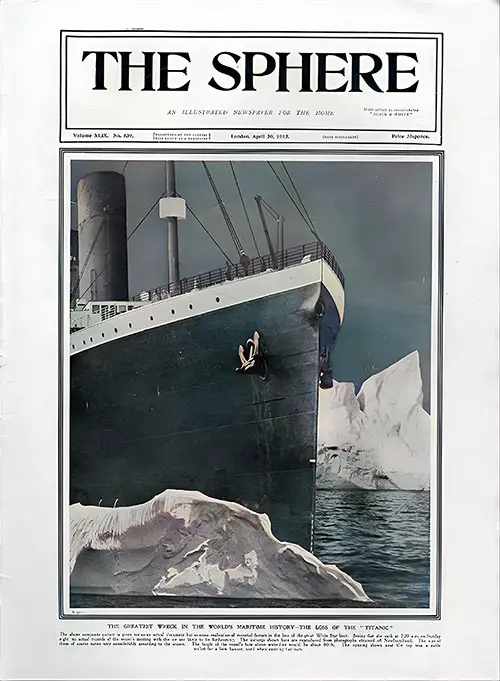
Front Cover, The Greatest Wreck in the World's Maritime History -- The Loss of the Titanic. The Sphere: An Illustrated Newspaper for the Home, Vol. XLIX, No. 639, With Supplement, London, 20 April 1912. GGA Image ID # 10f8be1bf0
The above composite picture is given not as an actual document but as some realization of essential factors in losing the great White Star liner. Seeing that she sank at 2:20 a.m. on Sunday, no records of the vessel's meeting with the ice will likely be forthcoming.
The icebergs shown here are reproduced from photographs obtained from Newfoundland. Their size, of course, varies considerably according to the season. The height of the vessel's bow above the water line would be about 60 ft. The opening shown near the top was a cable socket for a bow hawser, a device used to secure the ship when entering harbors, which was a common practice during the liner's voyages.

The Greatest Shipwreck in the World’s History: (Top) the Loss of the Titanic, Featured Photos Were the Sumptuous Appointments of the Titanic — the Parisian Café With Its Trelliswork and Climbing Plants; Boats Which Rescued Some of the Passengers — Seen to the Left of Promenade Deck. (Left Side) a Sitting Room of a Private Suite Showing Marble Fireplace and Costly Electrical Fittings; Cycle Rowing Machine in the Gymnasium Which Enabled the Passengers to Enjoy a Variety of Exercise on Board (Right Side) the Swimming Bath on the Titanic - the Biggest of Its Kind on Any Vessel, the Gymnasium on the Titanic - One Could Ride on a Mechanically Worked Saddle or Exercise Oneself As if in a Racing Skiff. (Middle/bottom) How the White Star Liner, Titanic, Encountered History: The Loss of the Titanic the Iceberg Stream From Greenland Waters. Drawn for the Sphere by John Duncan. The Sphere, 20 April 1912. GGA Image ID # 10f9026965
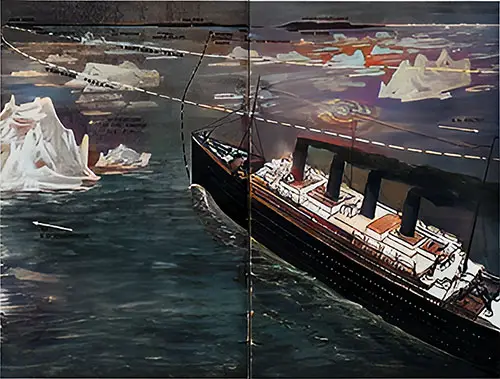
Diagrammatic View Shows the Position of the Titanic and the Surrounding Vessels. Drawn for the Sphere by John Duncan. The Sphere, 20 April 1912. GGA Image ID # 223fdc4775
How the White Star Liner, Titanic, Encountered History: The Loss of the Titanic the Iceberg Stream From Greenland Waters.
This Diagrammatic View, Which Has Been Drawn From the Telegraphic Descriptions, Shows the Position of the Titanic and the Surrounding Vessels. The Carpathia Was Away on the Port Bow, the Baltic Away to the Stern on the Starboard Side. The Ship Is Shown Entering the Main Stream of Bergs Flowing Southward From Greenland Waters—the Eastward and Westward Tracks of the Liners Were Complicated. The Titanic Appears to Have Sunk Near Sable Island. The Olympic Failed to Reach Her Sister Ship Owing to the Short Time the Titanic Remained Above Water, Highlighting the Urgency of the Rescue Operation. Four of the Vessel’s Sixteen Boats Are Shown Above.
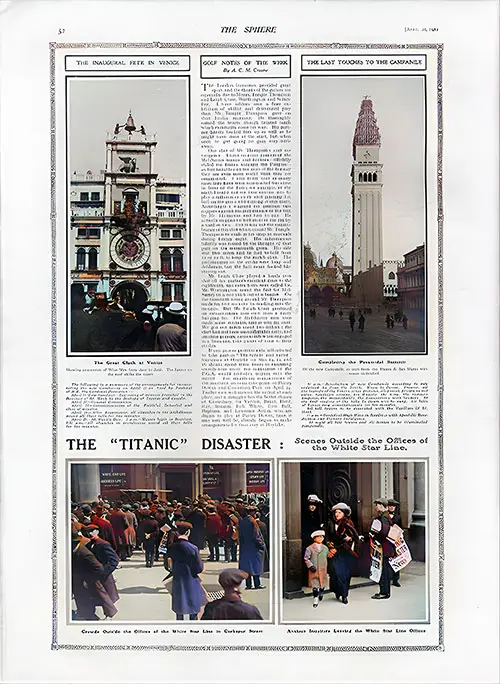
The Titanic Disaster: Scenes Outside the Offices of the White Star Line. Photos Include: (Left) Crowds Outside the Offices of the White Star Line in Cockspur Street; (Right) Anxious Inquirers Leaving the White Star Line Offices. (Top Section of This Page Is Unrelated to the Titanic). The Sphere, 20 April 1912. GGA Image ID # 10f939c35c

The Greatest Wreck in the World's History: The Loss of the White Star Liner Titanic, Which Sailed from Southampton on Wednesday, 10 April, and was totally lost of Newfoundland on Sunday Night (14 April). The Ship Now Lying Two Miles Deep in the Atlantic. The Sphere, 20 April 1912 Supplement. GGA Image ID # 10f9b9d891
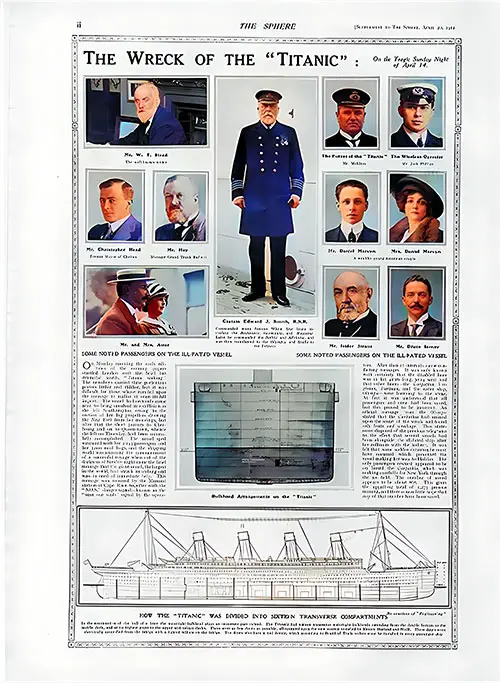
The Wreck of the Titanic: On the Tragic Sunday Night of 14 April 1912. Some Noted Passengers on the Ill-Fated Vessel includes (Left Side) Mr. W. T. Stead, Mr. Christopher Head, Mr. Hay, Mr. & Mrs, Astor. Right Side) The Purser of the Titanic Mr. McElroy, The Wireless Operator Mr. Jack Phillips, Mr., Daniel Marvyn, Mrs., Daniel Marvyn (A Wealthy Young American Couple), Mr. Isidor Straus, Mr. Bruce Ismay. (Center) Captain Edward J. Smith, R.N.R. Who Commanded Many Famous White Star Ships, Including the Britannic, Germanic, and Majestic. Later He Commanded the Baltic and Adriatic And Was Then Transferred to the Olympic and Finally to the Titanic. Also Bulkhead Arrangements on the Titanic and How the Titanic was Divided Into Sixteen Transverse Compartments. The Sphere, 20 April 1912 Supplement. GGA Image ID # 10f9d1dea1
How the Titanic Was Divided Into Sixteen Transverse Compartments
By courtesy of Engineering Magazine
The watertight bulkhead, a crucial part of liner construction, was a key safety feature of the Titanic. The ship was divided into sixteen transverse watertight bulkheads, each extending from the double bottom to the middle deck and at its highest point to the upper and saloon decks. The doors, as few as possible, were all part of a new system installed by Messrs. Harland and Wolff. These doors were electrically controlled from the bridge, with a lighted telltale on the bridge, and also had a hand device, a mandatory installation in every passenger ship according to Board of Trade orders, which played a significant role in ensuring safety standards.

Lost White Star Liner Titanic: How the Seven Decks Were Arranged on the Titanic. The View Shows the Vessel in Dock at Southampton. Her Double Bottom Is Shown (White) in the Section. the Description of Each Deck’s Uses Is Given on the Right-Hand Side. One of the Boats on Each Side Is Not in This View. the Vessel Carried Sixteen Lifeboats, Eight on Each Side, and Could Hold Sixty-Five Persons Each. The Sphere, 20 April 1912 Supplement. GGA Image ID # 10f9fed51f
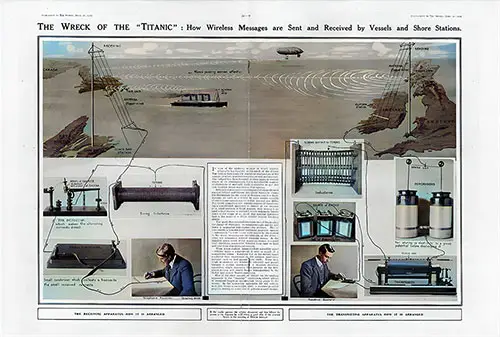
The Wreck of the Titanic: New Wireless Messages Are Sent and Received by Vessels and Shore Stations. (Left Side) Arrangement of the Receiving Apparatus. (Right Side) Arrangement of the Transmitting Apparatus. The Sphere, 20 April 1912 Supplement. GGA Image ID # 10fa271e91
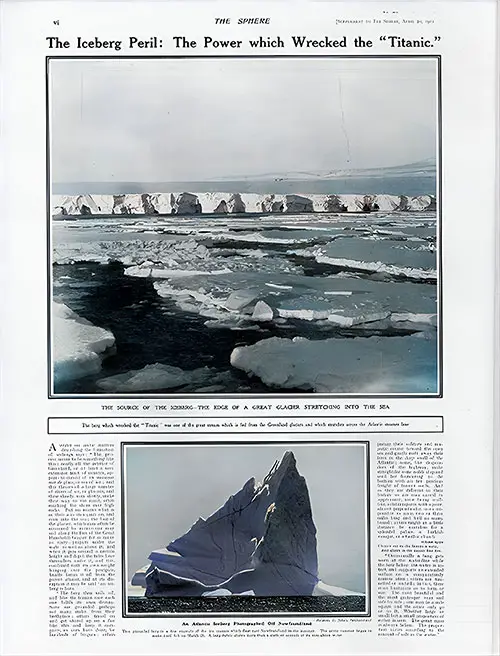
The Iceberg Peril: The Power Which Wrecked the Titanic. (Top) The Source of the Iceberg - The Edge of a Great Glacier Stretching Into the Sea. The Iceberg That Sank the Titanic Originated From Greenland Glaciers and Extended Across the Atlantic Shipping Lane. (Bottom) An Atlantic Iceberg Photographed off Newfoundland. This Towering Iceberg Is an Excellent Example of the Ice Masses That Float Past Newfoundland During the Summer. the Arctic Summer Began to Make Its Presence Felt on March 21. an Iceberg Typically Reveals Only About One-Sixth or One-Seventh of Its Total Size Above the Water. Photo by Holloway, St. John’s , Newfoundland. The Sphere, 20 April 1912 Supplement. GGA Image ID # 10fa92d128
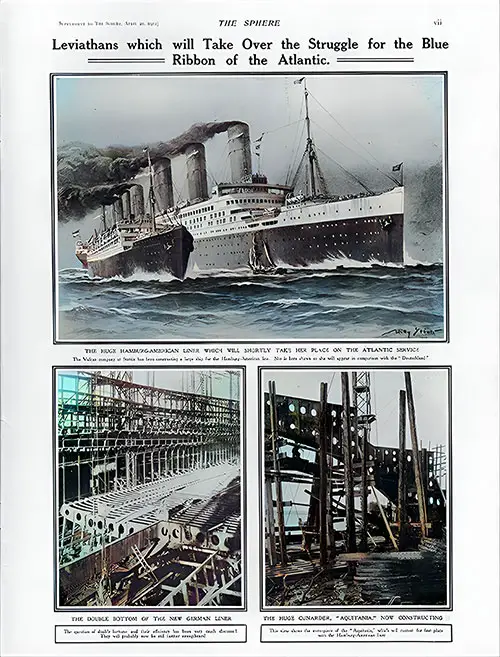
Leviathans Which Will Take Over the Struggle for the Blue Ribbon of the Atlantic. (Top) The Huge Hamburg America Liner Which Will Shortly Take Her Place on the Atlantic Service. The Vulcan Company in Stettin Is Constructing a Large Ship for the Hamburg-American Line. It Is Shown Here in Comparison With the Deutschland. Illustration by Willy Töwel. (Bottom Left) View of the Double Bottom of the New German Liner. The Effectiveness of Double Bottoms Has Been Widely Debated. They Are Likely to Become Even More Relevant. (Bottom Right) The Huge Cunarder, Aquitania, Now Constructing. This View Displays the Stern of the Aquitania, Which Is Competing for First Place Against the Hamburg-American Liner. The Sphere, 20 April 1912 Supplement. GGA Image ID # 10facfd9b7
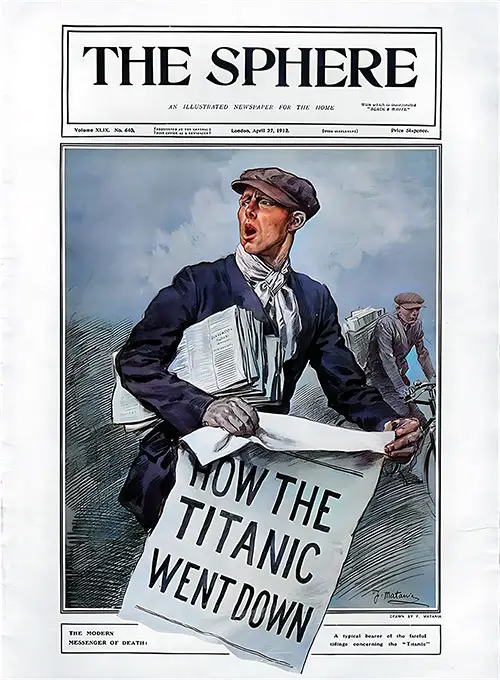
Front Page, How the Titanic Went Down. The Modern Messenger of Death: A Typical Bearer of the Fateful Tidings Concerning the Titanic. Drawing by F. Matania. The Sphere, 27 April 1912. GGA Image ID # 10fb1530d3
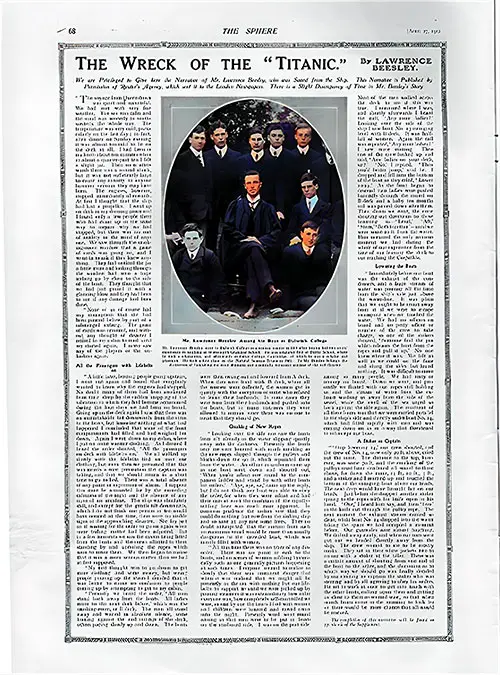
The Wreck of the Titanic by Lawrence Beesley. We Are Honored to Present the Account of Mr. Lawrence Beesley, Who Was Rescued From the Ship. This Narrative Was Published With Permission From the Reuters Agency, Which Distributed It to Newspapers in London. Please Note a Slight Discrepancy in the Timeline of Mr. Beesley’s Account. Photo Caption: Mr. Lawrence Beesley Among His Boys at Dulwich College. In 1904, Mr. Lawrence Beesley went to Dulwich College as a science master after having two years ' experience teaching at Wirksworth Grammar School. He was educated first at Derby School, where he received a scholarship, and afterward at Caius College, Cambridge, where he was a scholar and prizeman. He took a first class in the Natural Science Tripos in 1903. To Mr. Beesley belongs the distinction of furnishing the most dramatic and essentially veracious account of the sad disaster. The Sphere, 27 April 1912. GGA Image ID # 10fb61915d
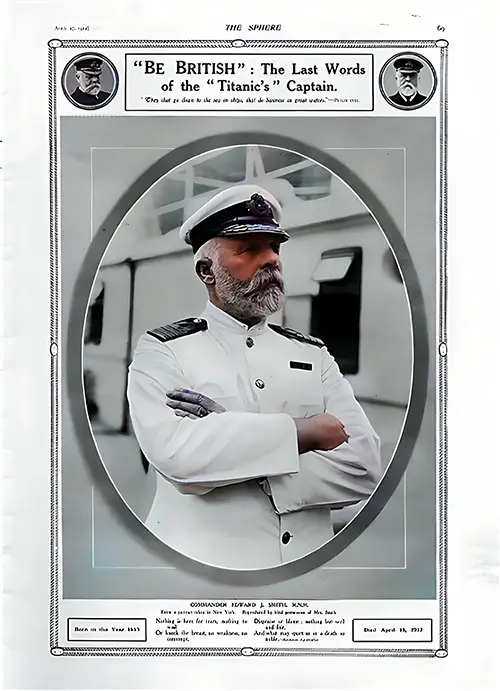
Commander Edward J. Smith, R.N.R. (1853-1912) "Be British": The Last Words of the Titanic's Captain. "They that go down to the sea in a ship, that do business in great waters." -- Psalm CVII. From a Portrait Taken In New York and Reproduced by Kind Permission of Mrs. Smith. Nothing Is Here for Tears, Nothing to Wail or Knock the Breast, No Weakness, No Contempt, Dispraise or Blame; Nothing but Well and Fair, and What May Quiet Us in a Death so Noble. - Samson Agonistes. The Sphere, 27 April 1912. GGA Image ID # 10fb7468d3
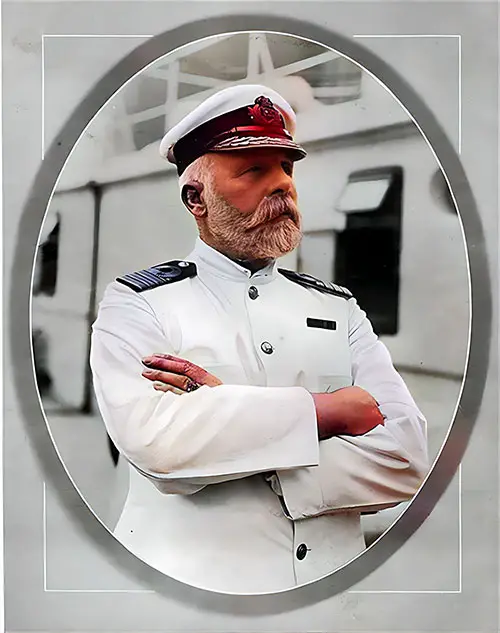
The Late E. J. (Edward James ) Smith, RNR, Captain of the RMS Titanic and Commodore of the White Star Line (27 January 1850 – 15 April 1912). The Sphere, 27 April 1912. GGA Image ID # 110a8ff688
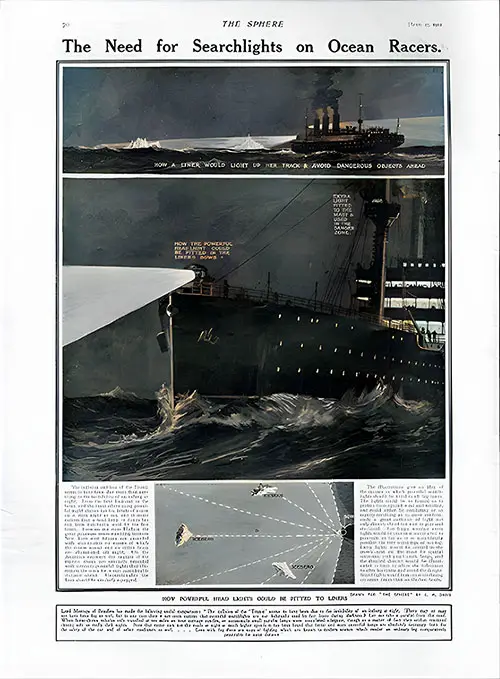
The Need for Searchlights on Ocean Racers. Illustration Demonstrate How Powerful Head Lights Could Be Fitted to Liners. (Top) How a liner would light up her track and avoid dangerous objects ahead. (2nd from Top) How the powerful headlight could be fitted in the liner's bows. Extra light fitted to the mast and used in the danger zone. Drawn for the Sphere by G. H. Davis. The Sphere, 27 April 1912. GGA Image ID # 10fbc386f8
How Powerful Head Lights Could Be Fitted to Liners
Lord Montagu of Beaulieu has made the following helpful comparison: The collision of the Titanic seems to have been due to the invisibility of an iceberg at night. There may or may not have been fog, but does it not seem curious that fast liners do not habitually use powerful searchlights during darkness?
This historical context of transportation safety, particularly the weight of past tragedies like the Titanic, underscores the need for continuous improvement. Let me take a parallel from the road.
Consider the evolution of safety measures in transportation. In the era of horse-drawn vehicles, traveling at a modest ten miles an hour, carriage candles or occasionally small paraffin lamps were deemed sufficient. However, they were of little use on moonless nights.
Fast forward to the present, with motor cars zipping along the roads at much higher speeds, and we find ourselves in need of better and more powerful lamps for the safety of the vehicle and other road users.
This evolution, as I will demonstrate, is a testament to the progress in transportation safety. Even with the challenge of fog, modern science has found ways to light the way, making ordinary fog relatively penetrable for some distance.

The Aftermath of Sorrow: How the Tragedy Came Home to Many a Householder in Southampton. The Scene Outside the White Star Offices at Southampton. Drawn for the Sphere by H. M. Paget. The Sphere, 27 April 1912. GGA Image ID # 10fbdf883f
A Scene Outside White Star Offices in Southampton
Our artist, who visited the grief-stricken town last Saturday, witnessed a scene outside the White Star offices in Southampton. There was a painful contrast between delight and blank despair as anxious relatives or friends of those who had sailed on the Titanic recognized the long-sought names posted on the official list while others sought them in vain.
Not until the board containing the last fateful list of survivors had been removed did the devoted watchers leave the offices. Over 600 relatives of drowned members of the crew attended a memorial service in St. Mary's Church on Sunday. It is estimated that there are fully 2,000 crew dependents in the town.
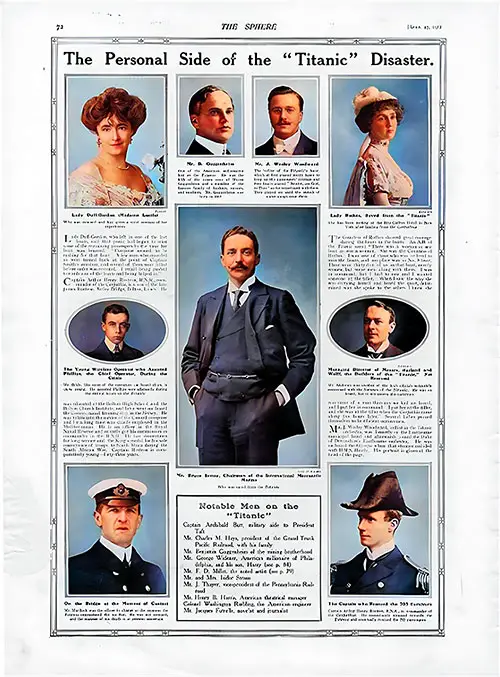
The Personal Side of the Titanic Disaster. Notable Passengers Include Lady Duff-Gordon (Madame Lucile), Mr. Bride, Mr. Murdoch, Mr. B. Guggenheim, Mr. J. Wesley Woodward, Mr. Bruce Ismay, Lady Rothes, Mr. Andrews, and Notable Men on the Titanic. Captain Arthur Henry Rostron, R.N.R. of the Carpathia is Pictured on the Bottom Right. The Sphere, 27 April 1912. GGA Image ID # 10fd1f81c7
Insert: Notable Men on the "Titanic"
- Captain Archibald Butt, military aide to President Taft
- Mr. Charles M. Hays, president of the Grand Trunk Pacific Railroad, with his family
- Mr. Benjamin Guggenheim of the mining brotherhood
- Mr. George Widener, American millionaire of Philadelphia, and his son , Harry
- Mr. F. D. Millet, the noted artist
- Mr. and Mrs. Isidor Straus
- Mr. J. Thayer, vice-president of the Pennsylvania Railroad
- Mr. Henry B. Harris, American theatrical manager
- Colonel Washington Ræbling, the American engineer
- Mr. Jacques Futrelle, novelist and journalist
Text/Captions from Personal Side of Titanic
Lady Duff-Gordon, who left in one of the last boats, said that panic had begun to seize some remaining passengers when her boat was lowered. Everyone seemed to be rushing for that boat. A few men who crowded in were turned back at the point of Captain Smith's revolver, and several of them were felled before order was restored. I recall being pushed towards one of the boats and being helped in.
Mr. Benjamin Guggenheim was one of the American millionaires lost on the Titanic. He was the fifth of the seven sons of Meyer Guggenheim and a member of the famous family of bankers, miners, and smelters. Mr. Guggenheim was born in 1865.
Mr. J. Wesley Woodward. At first, the cellist of the Titanic's band played merry tunes to keep up the passengers' courage and then finally played Nearer, my God, to Thee" as the vessel sank with them. They played on until the inrush of water swept over them. Mr. J. Wesley Woodward, cellist in the Titanic orchestra, was formerly in the Eastbourne municipal band and afterward joined the Duke of Devonshire's Eastbourne orchestra. He was on board the Olympic when that steamer collided with H.M.S. Hawke. His portrait is given at the head of the page.
Lady Rothes, Saved from the Titanic (Photo by Lafayette). She has been resting at the Ritz-Carlton Hotel in New York since leaving Carpathia. The Countess of Rothes showed great courage during the hours in the boats. An A.B. of the Titanic says: "There was a woman in my boat as was a woman. She was the Countess of Rothes. I was ordered to operate the boats, and my place was in the No. 8 lifeboat. There were thirty-five of us in that boat, mostly women, but some men along with them. I was in command, but I had to row and wanted someone at the tiller. When I saw how she was carrying herself and heard the quiet, determined way she spoke to the others, I knew she was more of a man than any we had on board, and I put her in command. I put her at the tiller, and she was there when the Carpathia came along five hours later." Several ladies proved themselves to be efficient oarswomen.
Mr. Bride, The Young Wireless Operator who Assisted Phillips, the Chief Operator, during the Crisis, Mr. Bride, is quite young, like most of the operators on board ships. He assisted Phillips very efficiently during the critical hours on the Titanic.
Mr. Murdock, On the Bridge at the Moment of Contact, Mr. Murdock was the officer in charge when the Titanic encountered the ice floe. He was not rescued, and the manner of his death is currently uncertain.
Mr. Andrews, Managing Director of Messrs. Harland and Wolff, the Builders of the Titanic, Not Rescued. Mr. Andrews was another of the high officials intimately concerned with the ship's fortunes. He was on board but is not among the survivors.
Captain Arthur Henry Rostron, R.N.R., The Captain who Rescued the 705 Survivors, is the commander of the Carpathia. He immediately steamed towards the Titanic and eventually rescued the 705 passengers. Captain Arthur Henry Rostron, R.N.R., commander of the Carpathia, is a son of the late James Rostron, Astley Bridge, and Bolton Lanes. He was educated at the Bolton High School and the Bolton Church Institute and later went on board the Conway naval training ship in the Mersey. He was taken into the service of the Cunard company and, for a long time, was chiefly employed in the Mediterranean. He is an officer in the Roval Naval Reserve and recently got his commission as commander in the R.N.R. He has decorations for long service and the King's medal for his safe conveyance of troops to South Africa during the South African War. Captain Rostron is a comparatively young man of forty-three years.
Mr. Bruce Ismay, Chairman of the International Mercantile Marine, was saved from the Titanic.
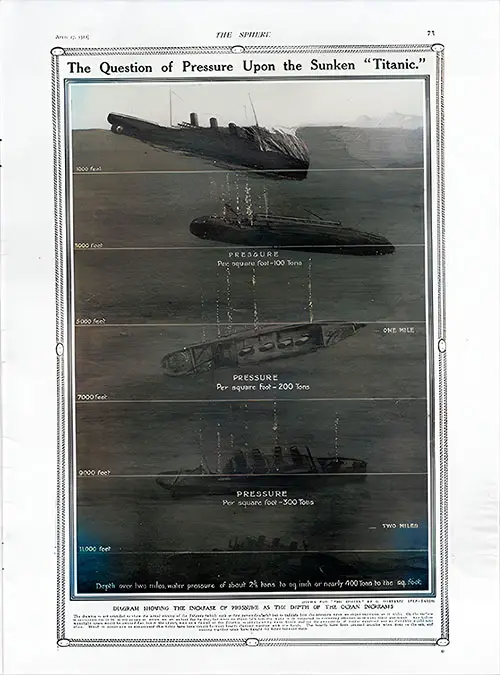
The Question of Pressure Upon the Sunken Titanic. Diagram Showing the Increase in Pressure As the Depth of the Ocean Increases. at 5000 Feet, the Pressure per Square Foot Is 100 Tons. 7,000 Feet: 200 Tons Pressure per Square Foot. 11,000 Feet: 300 Tons Pressure per Square Foot. Depth Over Two Miles, Water Pressure of About 2 1/2 Tons per Square Inch or Nearly 400 Tons per Square Foot. Drawn for the Sphere by G. Torrance Stephenson. The Sphere, 27 April 1912. GGA Image ID # 10fdab3376
Diagram Showing the Increase of Pressure As the Depth of the Ocean Increases
The drawing is not intended to show the actual sinking of the Titanic (which sank at first perpendicularly) but to indicate how the pressure upon an object increases as it sinks. On the surface, it encounters the 15 lb. to the square, which we all endure daily. Still, when an object falls into the water, it is subjected to increasing pressure as it sinks lower and lower. Any hollow watertight space would be pressed flat, but if the object, such as a funnel of the Titanic, is penetrated water inside and out, the pressure is equalized, and no distortion would take place. Wood is sometimes so compressed that fish have been caught between boards clamped together with iron bands. The boards have been pressed asunder when deep in the sea, and .coming together again have caught the fishes between them.
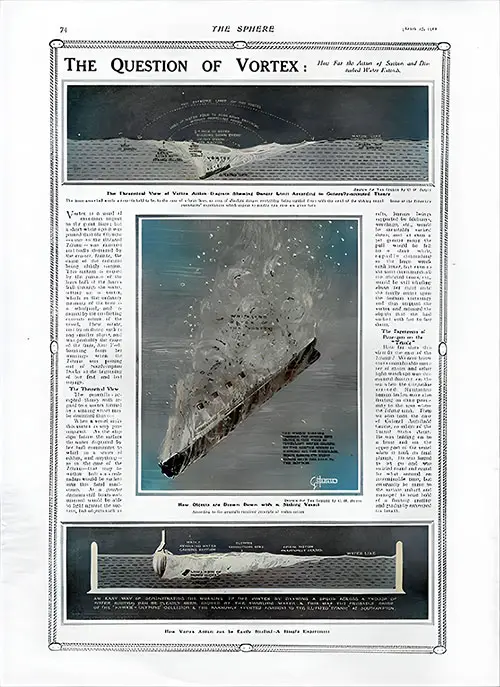
The Question of Vortex: How Far the Action of Suction and Disturbed Water Extends. (Top) the Theoretical View of Vortex Action-Diagram Showing Danger Limit According to Generally Accepted Theory. the Inner Area, Half a Mile Across, Is Held to Be, in the Case of a Large Liner, an Area of Absolute Danger, Everything Being Carried Down With the Swirl of the Sinking Vessel. Some of the Titanic’s Passengers’ Experiences That Modify This View Are Given Here. Drawn for The Sphere by G. H. Davis. (Middle) How Objects Are Drawn Down With a Sinking Vessel, According to the Generally Received Principle of Vortex Action. the Wreck Sinking Towards the Ocean Bed Above Is a Mass of Turbulant Water Caused by the Vortex Which Is Sucking All the Wreckage, Boats, Bodies, Etc., Right Down With the Ship to the Bottom. Drawn for The Sphere by G. H. Davis. (Bottom) How Vortex Action Can Be Easily Studied Through a Simple Experiment. An Easy Way of Demonstrating the Working of the Vortex by Drawing a Spoon Across a Trough of Water, Suction Can Be Clearly Seen Caused by the Swirling Water, and This Was the Probable Cause of the Hawke-Olympic Collision and Narrowly Averted Accident to the Ill-Fated Titanic at Southampton. The Sphere, 27 April 1912. GGA Image ID # 10fde5860c
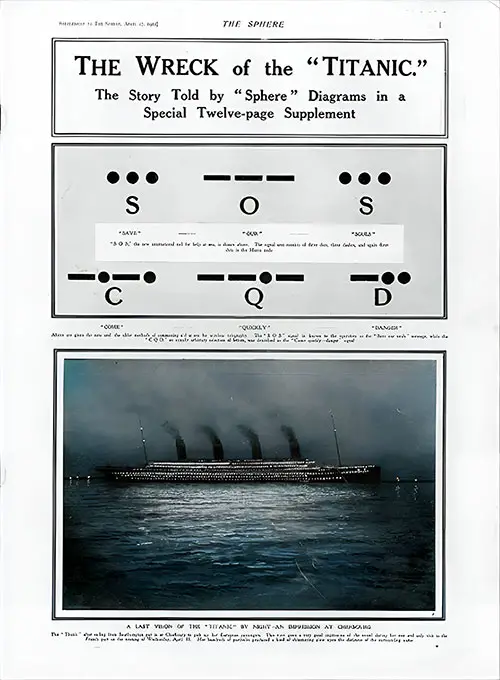
The Wreck of the Titanic. The Story Told by "Sphere" Diagram in a Special Twelve-Page Supplement. (Top) SOS, or Save Our Souls, Is the New International Call for Help at Sea, As Shown Abo E. the Signal Sent Consists of Three Dots, Three Dashes, and Again Three Dots in Morse Code: CQD, or Come Quickly Danger. That Signal Consisted of Dash Dot Dash Dot, Dash Dash Dot Dash, and Dash Dot D . the New and the Older Methods of Summoning Aid at Sea Are Given Above by Wireless Telegraphy. the SOS Signal Is Known to the Operators As the Save Our Souls Message, While the Cqd, an Equally Arbitrary Selection of Letters, Was Described As the Come Quickly-Danger Signal. (Bottom) A Last Vision of the Titanic by Night -- an Impression at Cherbourg. The Sphere, 27 April 1912 Supplement. GGA Image ID # 10fe01013a
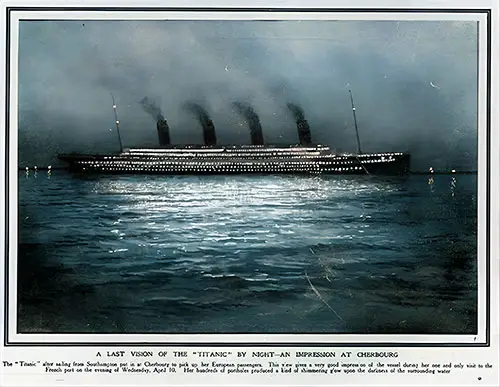
A Last Vision of the Titanic by Night -- An Impression at Cherbourg. The Titanic Arrived at Cherbourg After Sailing From Southampton to Pick Up Her European Passengers. This View Gives a Very Good Impression of the Vessel During Her Only Visit to the French Port on the Evening of Wednesday, 10 April 1912. Her Hundreds of Portholes Produced a Kind of Shimmering Glow Upon the Darkness of the Surrounding Water. The Sphere, 27 April 1912 Supplement. GGA Image ID # 11085e7c87
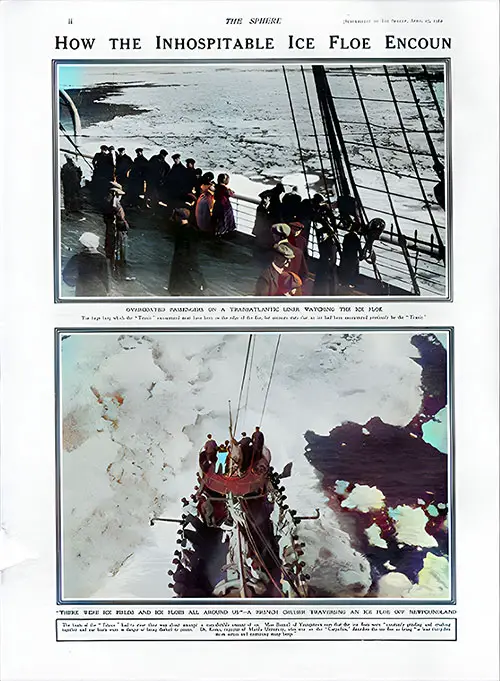
How the Inhospitable Ice Flow Encountered the Luxury of the Titanic.
(Top) Overcoated Passengers on a Transatlantic Liner Watching the Ice Flow. The Huge iceberg which the Titanic encountered must have been on the edge of the floe, for accouts state that no ice had been encountered previously by the Titanic. (Bottom) There were Ice Fields and Ice Flows All Around Us -- A French Cruiser Traversing an Ice Flow Off Newfoundland. The Titanic’s Lifeboats Had to Navigate Amongst a Considerable Amount of Ice. Miss Bonnell of Youngatown Says That the Ice Floes Were Constantly Grinding and Crashing Together, and Our Lifeboats Were in Danger of Being Dashed to Pieces. Dr. Kemp, Registrar of Manila University, Who Was on the Carpathia, Describes the Ice Floe As Being at Least Thirty-Five Miles Across and Containing Many Icebergs. The Sphere, 27 April 1912 Supplement. GGA Image ID # 10fe2f9494
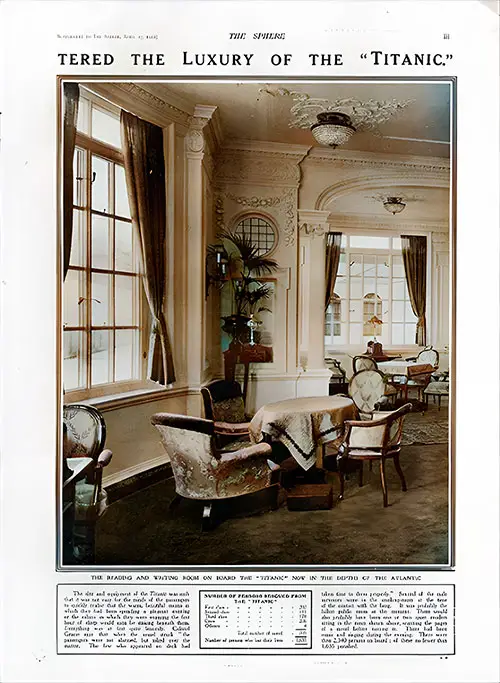
The Luxury of the Titanic. The Reading and Writing Room on board the Titanic Now in the Depths of the Atlantic. The Sphere, 27 April 1912 Supplement. GGA Image ID # 10fe4170df
The size and equipment of the Titanic made it difficult for the passengers to quickly realize that the warm, beautiful rooms in which they had been spending a pleasant evening or the cabins in which they were enjoying the first hour of sleep would soon be sinking beneath them.
Everything was, at first, quite leisurely. Colonel Gracie says that when the vessel struck, the passengers were not alarmed but joked over the
matter. The few who appeared on deck had taken time to dress appropriately. Several of the male survivors were in the smoking room at the time of the contact with the berg. It was the most packed public room at the moment.
There would also probably have been one or two quiet readers sitting in the room above, scanning a novel's pages before turning in. There had been music and singing during the evening. There were then 2,340 persons on board; of these, no fewer than 1,635 perished.
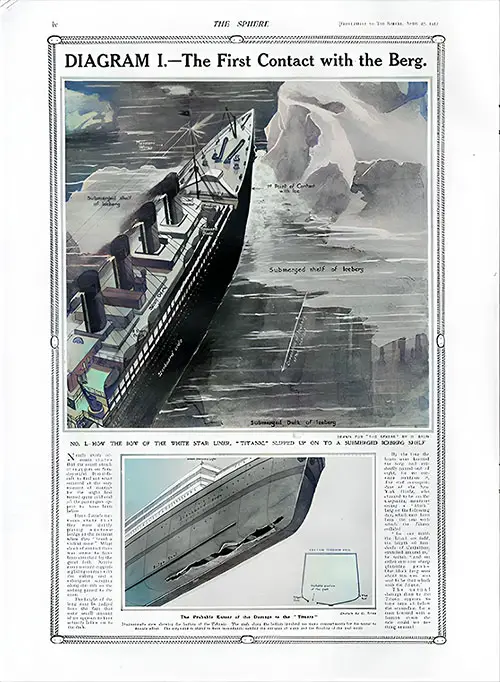
Diagram I: The First Contact with the Iceberg. (Top) How the Bow of the White Star Liner Titanic Slipped up on to a submerged iceberg shelf. Drawing for The Sphere by G. Bron. (Bottom) The Probable Extent of the Damage to the Titanic. This Is a Diagrammatic View of the Bottom of the Titanic. the Gash Along the Hull Breached Too Many Compartments, Preventing the Vessel From Remaining Afloat. the Carpenter Reportedly Notified the Crew Immediately About the Incoming Water and the Flooding of the Mailroom. The Drawing Is by G. Bron. The Sphere, 27 April 1912 Supplement. GGA Image ID # 10fed0d3d1

Diagram II: Scraping Past the Iceberg. Iceberg From 50 to 100 Feet According to Various Accounts. Through the Portholes, We Saw Ice Rubbing Against the Ship's Sides. Drawn for the Sphere by G. Torrance Stephenson The Sphere, 27 April 1912 Supplement. GGA Image ID # 10ffcf21de
Through the Portholes, We Saw Ice Rubbing Against the Ship's Sides
Mr. Beesley states that he talked with a few other passengers on reaching the deck. They had noticed the jar a little more and, looking through the window, had seen a huge iceberg go by close to the side of the boat. They thought we had just grazed it with a glancing blow, and they had been to see if any damage had been done. They even discussed the possibility of a collision and what they would do in such a scenario.
None of us, of course, had any conception that she had been pierced below by part of a submerged iceberg. The game of cards was resumed, and without any thought of disaster, I retired to my cabin to read until we started again. I never saw any of the players or the onlookers again. The quotation beneath the picture is from an account written by three French survivors. Only the height of the berg is suggested here. The length was very considerable.
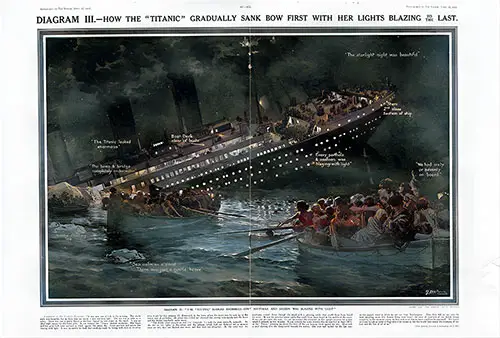
Diagram III. the Titanic Looked Enormous, With Every Porthole and Saloon Blazing With Light. How the "Titanic" Gradually Sank Bow First with Her Lights Blazing Til the Last. Drawn for the Sphere by F. Matania The Sphere, 27 April 1912 Supplement. GGA Image ID # 10ffda0600
Completion of Mr. Beesley's Narrative
It was now one o'clock in the morning. The starlit night was beautiful, but as there was no moon, it was not very light. The sea was as calm as a pond. There was a gentle heave as the boat dipped up and down in the swell. It was an ideal night except for the bitter cold. In the distance, the Titanic looked enormous. Her length and great bulk were outlined in black against the starry sky. Every porthole and saloon was blazing with light. It was impossible to think that anything could be wrong with such a leviathan were it not for that omnibus tilt downwards in the bows, where the water was now the lowest row of portholes. We observed her settling rapidly at about two o'clock, and the bridge was completely underwater.
She slowly tilted straight on end (see Diagram V.) with the stern vertically up. She did so. The lights in the cabins and the saloons, which had not flickered since we left, died out, flashed once more, and then went out altogether. At the same time, machinery roared down through the vessel with a groaning rattle that could have been heard in the middle of the ocean. It was not yet quite the end. To our amazement, she remained in that upright position for a time, which I estimate as five minutes. It was certainly for some minutes that we watched at least 150ft. of the Titanic towering up above the level of the sea, looming black against the sky.
Then, with a quiet slanting dive, she disappeared beneath the waters. Our eyes had looked for the last time on the gigantic vessel we set out from Southampton. Then there fell on our ears the most appalling noise that human beings had ever heard: the cries of hundreds of our fellow beings struggling in the icy water, crying for help with a cry that we knew could not be answered. We longed to return to pick up some of those swimming, but this would have meant the swamping of our boat and the loss of all of us.
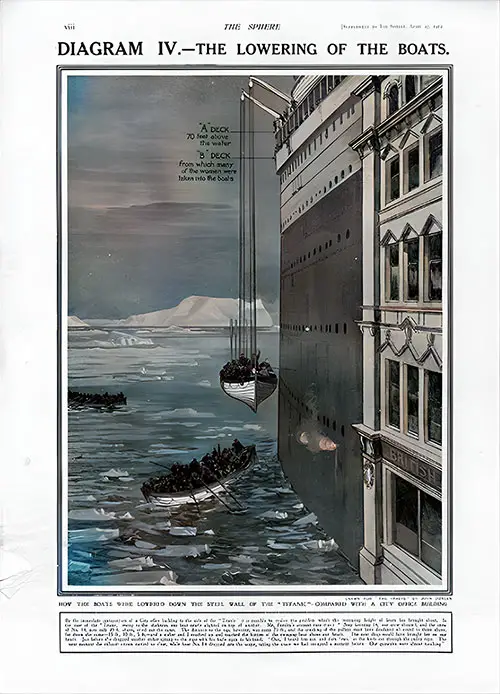
Diagram IV: The Lowering of the Lifeboats of the Titanic. "A" Deck was 70 feet above the water. "B" Deck from which many of the women were taken into the lifeboats. Drawn for the Sphere by John Duncan. The Sphere, 27 April 1912 Supplement. GGA Image ID # 10fff777b1
How the Lifeboats were lowered Down the Steel Wall of the Titanic Compared with a City Office Building
By the immediate juxtaposition of a City office building to the side of the Titanic, it is possible to realize the problem that the increasing height of liners has brought about. In the case of the Titanic, one boat nearly alighted on top of another due to the darkness.
Mr. Beesley's account runs thus: Stop lowering 14,' our crew shouted, and the crew of No. 14, now only 20 ft. above, cried out the same. The distance to the top, however, was some 70 ft. , and the creaking of the pulleys must have deadened all sound to those above, for down she came-15 ft., 10ft. , 5 ft.-and a stoker, and I reached up and touched the bottom of the swinging boat above our heads.
The next drop would have brought her on our heads. Just before she dropped, another stoker sprang to the rope with his knife open. I heard him say one and two as the knife cut through the pulley rope.
The next moment the exhaust stream carried us clear while boat No. 14 dropped into the water, taking the space we had occupied a moment before. Our gunwales were almost touching.
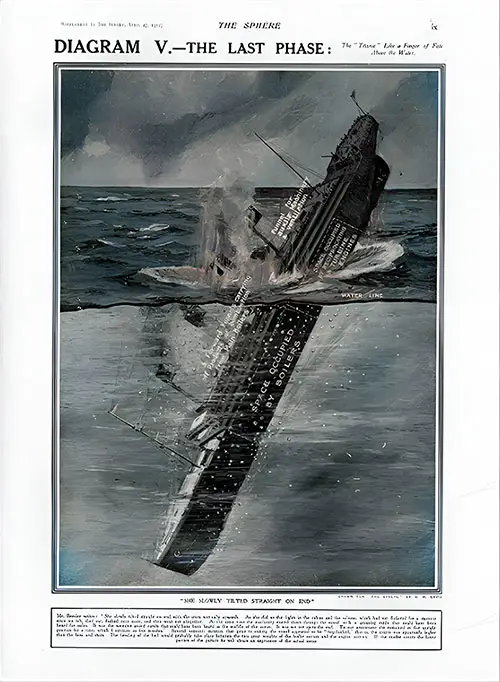
Diagram V: The Last Phase: The Titanic Like a Finger of Fate Above the Water. The Titanic Slowly Tilted Straight on End. Drawn for the Sphere by G. H. Davis. The Sphere, 27 April 1912 Supplement. GGA Image ID # 10fffeabda
Mr. Beesley writes: She slowly tilted straight on end with the stern vertically upwards. As she did so, the lights in the cabins and the saloons, which had not flickered for a moment since we left, died out, flashed once more, and then went out altogether. At the same time, the machinery roared down through the vessel with a groaning rattle that could have been heard for miles. It was the weirdest sound indeed that could have been heard in the middle of the ocean. It was not yet quite the end.
To our amazement, she remained upright for five minutes, which I estimate to be. Several accounts mention that before sinking, the vessel appeared to be " hog-backed, that is, the center was higher than the bow and stern. The hull bending is between the two great weights of the boiler section and the engine section. If the reader covers the lower portion of the picture, he will understand the scene.
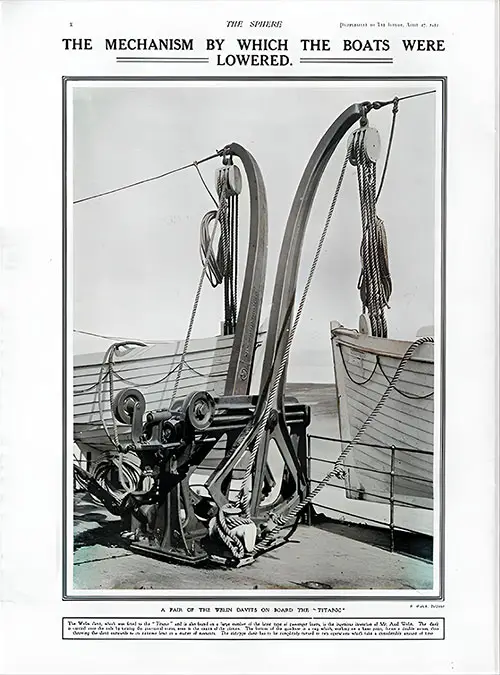
The Mechanism by Which the Lifeboats were Lowered. A Pair of Welin Davitts on Board the Titanic. Photo by R. Welch, Belfast. The Sphere, 27 April 1912 Supplement. GGA Image ID # 11007ae4db
The Welin Davits, which were fitted to the Titanic and are also found on many of the latest types of passenger liners, is the ingenious invention of Mr. Axel Welin. The davit is carried over the side by turning the gun-metal worm in the center of the picture. The bottom of the quadrant is a cog, which, working on a base point, forms a double action, thus throwing the davit outwards to its extreme limit in a matter of moments, ensuring the safety of the operation. The old-type davit has to be completely turned in two operations, which take considerable time.
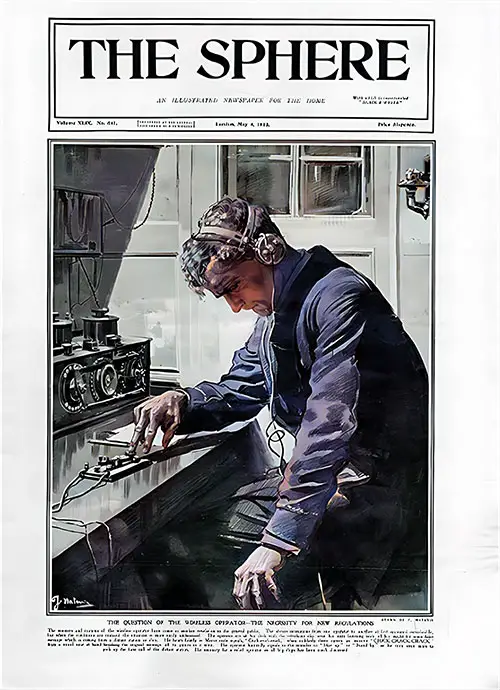
The Question of the Wireless Operator-The Necessity for New Regulations. Drawn by F. Matania. The Sphere, 4 May 1912. GGA Image ID # 1100b85efc
The wireless operator's manners and customs have become another revelation for the general public. The abrupt intimations from one operator to another at first appeared inexplicable. Still, the situation is more easily understood when the conditions are realized.
The operator sits at his desk with the telephone clip over his ears, listening with all his might to some faint message from a distant station or ship. He hears faintly in Morse code signals, " Crick -crick-crack," when suddenly there comes an incisive " CRICK-CRACK-CRACK " from a vessel near at hand, breaking the original message all to pieces as it were.
The operator hurriedly signals to the intruder to "Shut up or "Stand by" as he tries once more to pick up the faint call of the distant station. The necessity for a relief operator on all big ships has been discussed extensively.
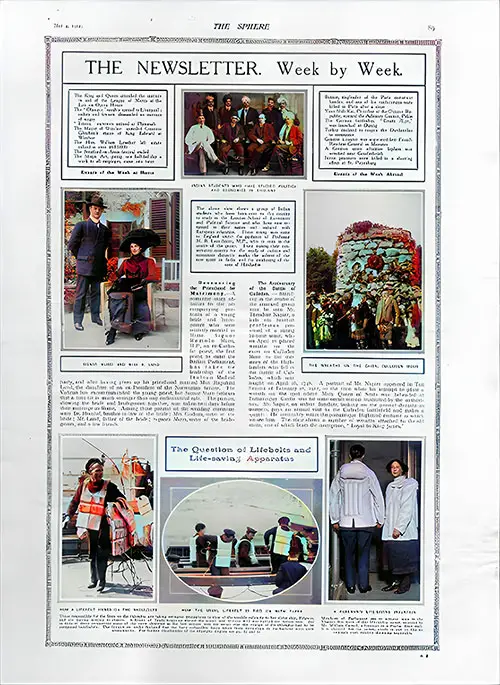
The Question of Lifebelts and Life-Saving Apparatus. (Bottom Row) (L) How a Lifebelt Hangs on the Shoulders (C) How a Typical Lifebelt Is Attached With Straps (R) a Foreman’s Life-Saving Invention. The Sphere, 4 May 1912. GGA Image ID # 110123e384
The Question of Lifebelts and Life-Saving Apparatus
Those responsible for the lives on the RMS Olympic are taking stringent precautions given the terrible calamity to her sister ship, Titanic, and are leaving nothing to chance. A Board of Trade inspector visited the vessel, and a lifeboat drill was carried out before him.
Despite these precautions, many of the crew deserted at the last minute, reportedly due to fear and uncertainty, resulting in the Olympics' voyage being postponed indefinitely. The firemen on strike declared that the forty collapsible boats taken from troopships in the harbor were quite unseaworthy.
Members of Parliament are to witness tests in the Thames this week of this life-saving jacket invented by Mr. William Carroll, a foreman in a Poplar flour mill. It is claimed that the jacket, which is put on like an ordinary coat, renders drowning impossible.
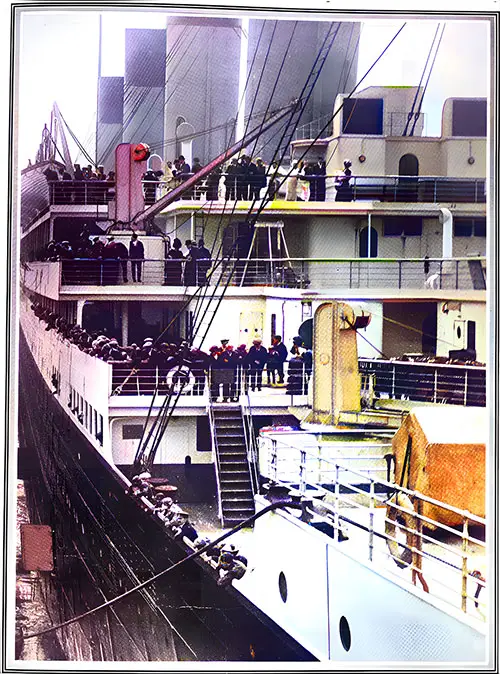
An Unusual View of Four of Her Decks as Passengers on the Olympic Await Events. This View Was Taken Last Week When the Passengers Aboard the Olympic Were Awaiting Events. in the Meantime, Arrangements Were Made For a Supply of London Newspapers to Be Sent to Them From Portsmouth and Ryde. During the Morning, the Ship’s Band Had Orchestral Concerts. Games Were Organised on Board, and Some Passengers Found
Recreation in Kite-Flying. Much Time Was Spent in the Gymnasium, Riding Horses and Indulging in Physical Drill. Elder Members Went In for Breathing Exercises. the Great Liner, Which Had Been Delayed Since Wednesday in the Solent, Returned to Port on the Friday Evening, When Her Passengers Disembarked. The Sphere, 4 May 1912. GGA Image ID # 223ff177db
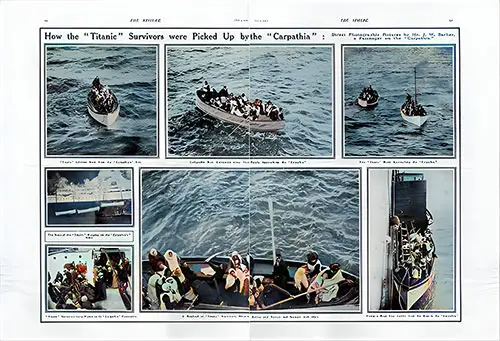
How the Carpathia Picked Up the Titanic Survivors. Direct Photographic Pictures by Mr. J. W. Barker, a Passenger on the Carpathia. (T to B, L to R) Titanic Lifeboat Seen From the Carpathia’s Side. Collapsible Boat Containing Some Thirty People Approaching the Carpathia. Two Titanic Lifeboats Approaching the Carpathia. the Lifeboats of the Titanic Hanging on the Carpathia’s Sides. Titanic Survivors Being Waited On by Carpathia Passengers. a Boatload of Titanic Survivors, Showing Babies and Women and Seamen With Oars. Fixing a Rope Step Ladder From the Boat to the Carpathia. The Sphere, 4 May 1912. GGA Image ID # 110125999a
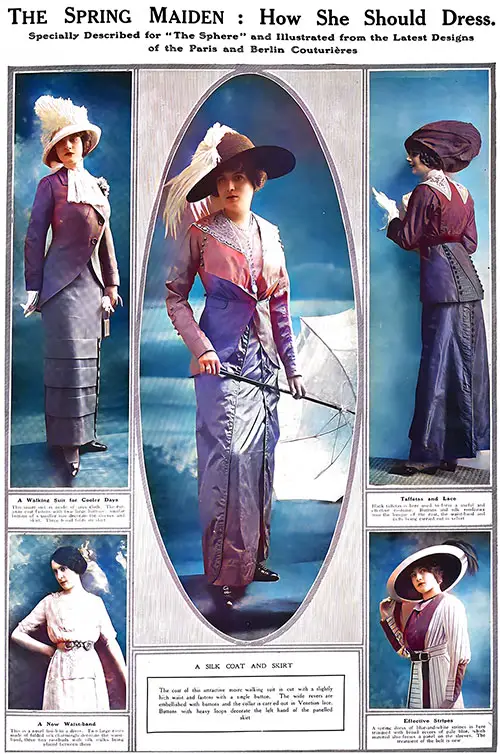
Titanic Fashions: The Spring Maiden: How She Should Dress. Specially Described for the Sphere and Illustrated With the Latest Designs From Paris and Berlin Couturiers. (Left Top) A Walking Suit for Cooler Days. This Stylish Suit Is Made From Grey Fabric. the Cutaway Coat Fastens With Two Large Buttons, and Smaller Similar Buttons Adorn the Sleeves and Skirt. the Skirt Features Three Broad Folds. (Left Bottom) A New Waistband Is a Novel Finishing Touch for a Dress. Two Large Folded Silk Roses Charmingly Adorn the Waistband, With Three Tiny Rosebuds Featuring Silk Stalks Positioned Between Them. (Right Top) Black Taffeta Is Used to Create a Valuable and Effective Costume. the Basque of the Coat Is Trimmed With Buttons and Silk Rouleaux, While the Waist-Band and Cuffs Are Made of Velvet. (Right Bottom) A Spring Dress in Blue-And-White Stripes Is Adorned With Broad Pale Blue Trims, Creating Panels on the Sleeves. The Belt Design Is New. (Center) A Silk Coat and Skirt. This Attractive Moiré Walking Suit Features a Coat Designed With a Slightly High Waist and Fastened With a Single Button. the Wide Lapels Are Adorned With Buttons, and the Collar Is Made From Venetian Lace. the Panelled Skirt Is Decorated With Buttons Featuring Heavy Loops on the Left Side. The Sphere, 4 May 1912. GGA Image ID # 224034e03c
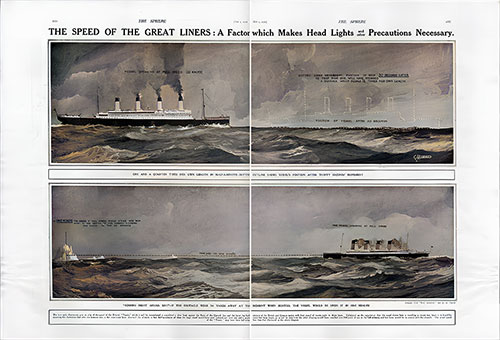
The Speed of the Great Liners Is a Factor That Makes Headlights and Other Precautions Necessary. (Top) The Vessel Is Steaming at Full Speed (22 Knots). Dotted Lines Represent the Position of the Ship 30 Seconds Later. in That Time, She Will Have Traveled a Distance Equal to 1 1/4 Times Her Length. (Bottom) In One Minute, the Vessel Traveling at Full Speed Would Strike the Iceberg’s Bow Right at the Center, Covering 744 Yards in Those 60 Seconds. The Sphere, 4 May 1912. GGA Image ID # 1101b8f401
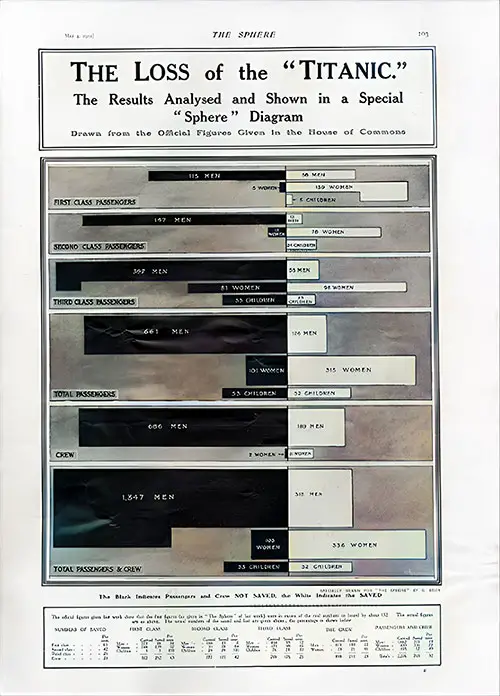
The Loss of the Titanic Was Analyzed and Presented in a Unique Sphere Diagram Based on the Official Figures From the House of Commons. The Black Color Indicates Passengers and Crew Members Who Were Not Saved, While the White Color Indicates Those Who Were Saved. The Sphere, 4 May 1912. GGA Image ID # 1101df2398
The Official Figures Given Last Week Show That the First Figures (As Provided in the Sphere of the Previous Week) Were More Than the Real Numbers on Board by About 132. the Actual Figures Are as Above. the Numbers of the Saved and Lost Are Given Above; the Percentage Is Shown Below.
Numbers of Saved: First Class 63%, Second Class 42%, Third Class 25%, and Crew 23%.
First Class: Men: 173 Carried, 58 Saved (34%). Women: 144 Carried, 139 Saved (97%). Children: 5 Carried, 5 Saved (100%). Total Carried 322, Total Saved 202 (63%).
Second Class: Men: 160 Carried, 13 Saved (6%). Women: 93 Carried, 78 Saved (84%). Children: 24 Carried, 24 Saved (100%). Total Carried 277, Total Saved 115 (42%).
Third Class: Men: 454 Carried, 55 Saved (12%). Women: 179 Carried, 98 Saved (55%). Children: 76 Carried, 23 Saved (30%). Total Carried 709, Total Saved 176 (25%).
The Crew: Men: 875 Carried, 189 Saved (22%). Women: 23 Carried, 21 Saved (91%). Total Carried 898, Total Saved 210 (23%).
Passengers and Crew: Men: 1,662 Carried, 315 Saved (19%). Women: 439 Carried, 336 Saved (77%). Children: 105 Carried, 52 Saved (49%). Total Carried 2,206, Total Saved 703 (32%)
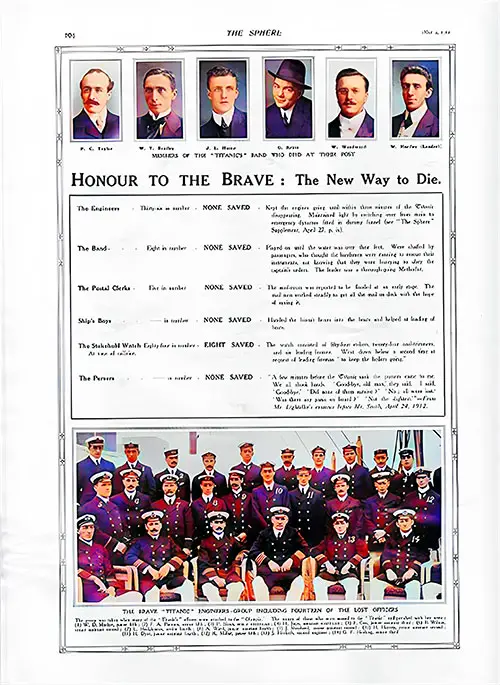
Honoring the Brave: A New Approach to Death. (Top) Members of the Titanic’s Band Who Died at Their Post. P. C. Taylor, W. T. Brailey, J. L. Hume, G. Krins, W. Woodward, and W. Hartley (Leader). (Bottom) The Courageous Engineers of the Titanic, Which Included Fourteen of the Lost Officers. The Sphere, 4 May 1912) p. 104. GGA Image ID # 11020661af
Group Photo of Titanic Engineers
The Group of Titanic Engineers Mentioned Was Formed When Many of the Officers From the Titanic Were Transferred From the Olympic. the Following Individuals Were Moved to the Titanic and Tragically Perished With Her:
1. W. D. Mackie, Junior, Fifth Engineer
2. F. a. Parsons, Senior Fifth Engineer
3. P. Sloan, Senior Electrician
4. H. Jupe, Assistant Electrician
5. F. Coy, Junior Assistant Third Engineer
6. B. Wilson, Senior Assistant Second Engineer
7. L. Hodgkinson, Senior Fourth Engineer
8. a. Ward, Junior Assistant Fourth Engineer
9. J. Shepherd, Junior Assistant Second Engineer
10. H. Harvey, Junior Assistant Second Engineer
11. H. Dyer, Junior Assistant Fourth Engineer
12. R. Millar, Junior Fifth Engineer
13. J. Hesketh, Second Engineer
14. G. F. Hosking, Senior Third Engineer
Centerpiece: The Total Loss Of Certain Crew Members
The Engineers Thirty-six in number - NONE SAVED. Kept the engines going until within three minutes of the Titanic disappearing. Maintained light by switching from primary to emergency dynamos fitted in dummy funnel.
The Band—eight in number—NONE SAVED. They played on until the water was over their feet. Passengers chaffed them, thinking the bandmen were running to rescue their instruments, not knowing that they were hurrying to obey the captain's orders. The leader was a thorough-going Methodist.
The postal clerks were five in number—NONE SAVED. The mailroom was reported to be flooded at an early stage. The mailmen worked steadily to get all the mail on deck in the hope of saving it.
Ship's Boys ?? in number NONE SAVED. Handed the biscuit boxes into the lifeboats and helped with the loading of lifeboats.
The Stokehold Watch was Eighty-four in number At the time of the collision. EIGHT SAVED. The watch consisted of fifty -four stokers and twenty-four coal trimmers; they went down below the second time at six leading firemen—the request of the leading fireman to keep the boilers going.
The Pursers ?? in number NONE SAVED. A few minutes before the Titanic sank, the pursers came to me. We all shook hands. Goodbye, old man, they said. I said, Goodbye. Did none of them survive? 'No; all were lost. Was there any panic on board? 'Not the slightest. - From Mr. Lightoller's evidence before Mr. Smith, April 24, 1912.
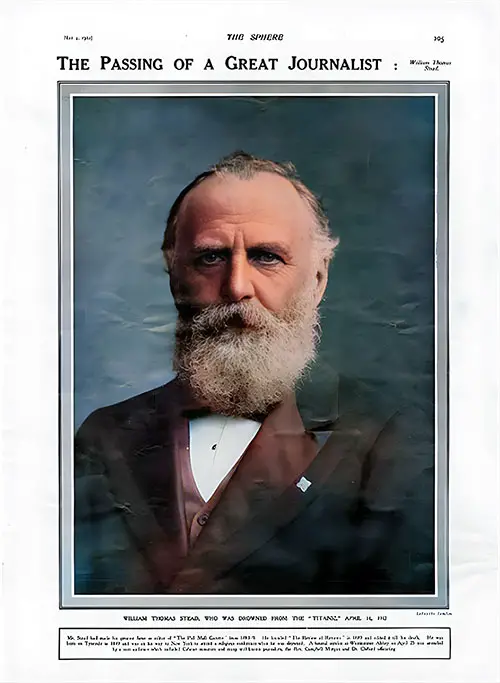
The Passing of a Great Journalist: William Thomas Stead. William Thomas Stead, Who Drowned in the Titanic Disaster on April 14, 1912. Photo by Lafayette, London. Mr. Stead Made His Greatest Fame as Editor of the Pall Mall Gazette From 1883 to 1889. He Founded the Review of Reviews in 1889 and Edited It Until His Death. Born on Tyneside in 1849, He Was on His Way to New York to Attend a Religious Conference When He Was Drowned. a Funeral Service at Westminster Abbey on April 25, 1912, Was Attended by a Vast Audience, Which Included Cabinet Ministers and Many Well-Known Journalists, the Rev. Campbell Morgan and Dr. Clifford Officiating. The Sphere, 4 May 1912. GGA Image ID # 110224724c
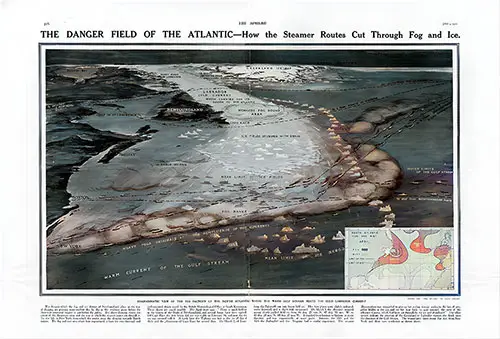
The Atlantic’s Danger Zone: Navigating Steamer Routes Through Fog and Ice. Diagrammatic View of the Fog Factory of the North Atlantic Where the Warm Gulf Stream Meets the Cold Labrador Current. Drawn for the Sphere by John Duncan. The Sphere, 4 May 1912. GGA Image ID # 110231a14c
Diagrammatic View of the Fog Factory of the North Atlantic Where the Warm Gulf Stream Meets the Cold Labrador Current
The dangers that the fog and ice district off Newfoundland poses to shipping are becoming more evident daily as the evidence presented to the American senatorial inquiry, a significant investigation into maritime safety, is made public. The above drawing shows the extent of the dangerous area and how the steamer routes cut through it.
To the left is New York, from which the routes cross the drawing towards British waters. The fog and mist area chart here reproduced is from the very thorough and well-executed sheets issued by the British Meteorological Office at South Kensington, which are crucial for understanding and navigating through these hazardous conditions.
These charts are issued monthly. The April charts say: There is much field ice near the Banks of Newfoundland, and several icebergs have been sighted Off Cape Race. The first heavy slob ice was visible on February 16; the next day, the sea was covered with it. A week later, for several days, Tabasco was fast in the ice off Bay Bulls and the Almeriana off Cape Race.
On March 2, off Lomberg, the Isleworth ran into heavy field ice. The force of the impact was such that her bow plates were slightly indented, rivets loosened, and a slight leak occasioned. This incident serves as a stark reminder of the potential dangers lurking in these waters.
Between the 10th and the 12th, the Indraghiri and the Niagara had similar experiences. The steamer Bonaventura was compelled to give up her sealing voyage owing to the loss of propeller blades in the ice. On her way back to port, she rescued the crew of the schooner Corona, which had been cut through by the ice and abandoned.
The white arrows indicate the direction of the Greenland or Labrador current, and the black ones indicate the direction of the Gulf Stream. As shown above, the transatlantic liners steam due east from New York and then turn northeast.
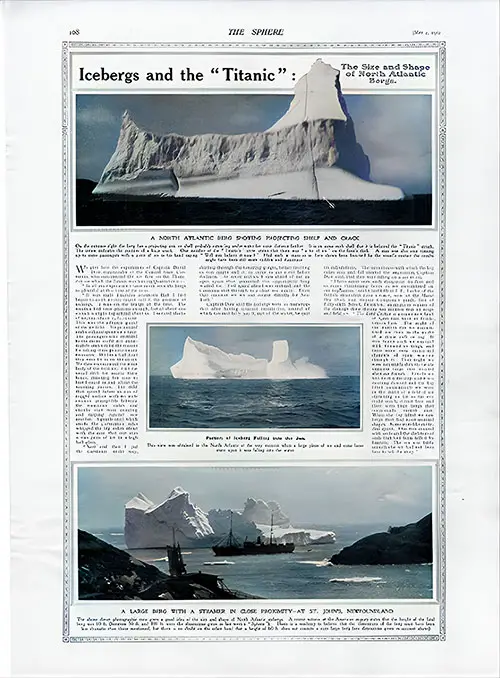
Icebergs and the Titanic: The Size and Shape of North Atlantic Icebergs. (Top) A North Atlantic Iceberg Is Displayed, Featuring a Projecting Shelf and a Crack. on the Far Right, the Iceberg Has a Protruding Arm or Shelf, Which Likely Extends Underwater for Some Distance. It Is Believed That the Titanic Struck a Similar Shelf. the Arrow Indicates the Location of a Significant Crack. One Member of the Titanic’s Crew Reported Considerable Ice on the Liner’s Deck. Additionally, a Man Was Seen Running Towards Some Passengers With a Piece of Ice, Exclaiming, Will You Believe It Now? if Such a Large Mass of Ice Had Been Dislodged Due to the Ship’s Impact, the Consequences Could Have Been More Sudden and Disastrous. (Middle) Part of an Iceberg Is Falling Into the Sea. This View Was Captured in the North Atlantic at the Exact Moment When a Large Piece of Ice, Along With Some Loose Snow on It, Plunged Into the Water. (Bottom) A Large Iceberg With a Steamer Nearby at St. John’s, Newfoundland. This Direct Photographic View Provides a Clear Idea of the Size and Shape of North Atlantic Icebergs. a Recent Witness at the American Inquiry Stated That the Height of the Fatal Iceberg Was 60 Feet. Last Week, the Dimensions Reported in the Sphere Ranged Between 50 and 100 Feet. While There Is a Tendency to Believe That the Iceberg’s Size May Have Been Less Dramatic Than Those Figures Suggest, It Is Clear That a Height of 60 Feet Does Not Indicate a Colossal Iceberg. The Sphere, 4 May 1912. GGA Image ID # 1102527a05
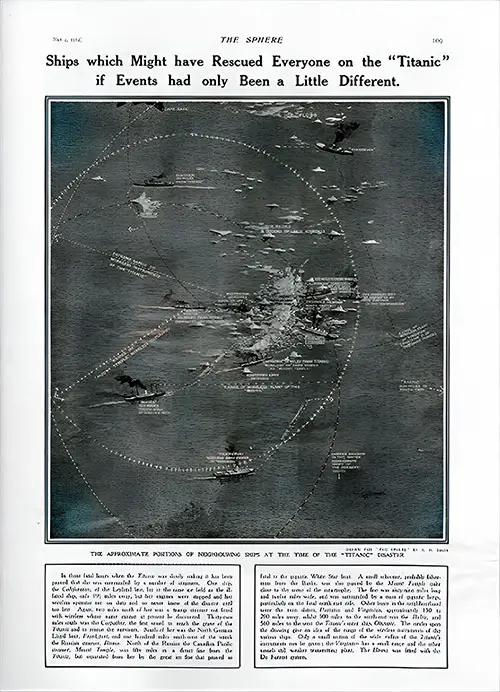
Ships That Could Have Rescued Everyone on the Titanic if Events Had Been Slightly Different—Map of the Approximate Positions of Neighboring Vessels at the Time of the Titanic Disaster. Drawn for the Sphere by G. H. Davis. The Sphere, 4 May 1912. GGA Image ID # 11027abdcb
In those fatal hours when the Titanic was slowly sinking, it was proved that several steamers surrounded her. One ship, the Californian of the Leyland line, lay in the same ice field as the ill-fated ship, only 195 miles away. Still, her engines were stopped, and her wireless operator was not on duty. Hence, she never knew of the disaster until too late. Again, two miles south of her was a tramp steamer not fitted with wireless whose name cannot be discovered.
Thirty-two miles south was the Carpathia, the first vessel to reach the Titanic's grave and rescue the survivors. South of her was the North German Lloyd boat, Frankfurt, and one hundred miles southwest of the wreck, the Russian steamer, Birma. North of the Russian ship, the Canadian Pacific steamer Mount Temple was fifty miles in direct line from the Titanic but separated from her by the great ice floe that proved so fatal to the gigantic White Star boat.
A small schooner, probably a fisherman from the Banks, was also passed by the Mount Temple quite close to the scene of the catastrophe. The floe was sixty-nine miles long and twelve miles wide and was surrounded by a mass of gigantic bergs, particularly on the fatal north-east side.
Other boats in the neighborhood were the twin sisters, Parisian and Virginian, approximately 150 to 200 miles away. Three hundred miles to the southeast was the Baltic, and 560 miles to the west was the Titanic's sister ship, Olympic. The circles on the drawing give an idea of the range of the wireless instruments of the various vessels.
Only a tiny section of the wide radius of the Titanic's instruments can be given; the Virginian has a small range, and the other vessels still have weaker transmitting plants. The Birma was fitted with the De Forrest system.
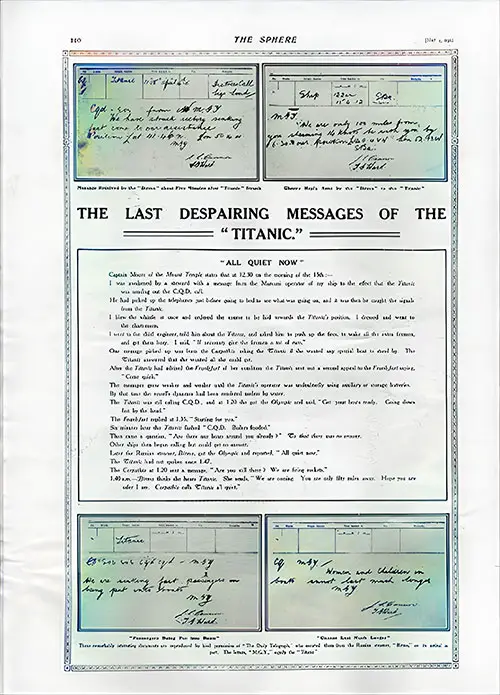
The Final Desperate Messages of the Titanic. These Intriguing Documents Are Reproduced With the Kind Permission of "The Daily Telegraph," Which Obtained Them From the Russian Steamer, Birma, Upon Its Arrival in Port. the Letters M.G.Y. Signify the Titanic. (Top) Message Received by the SS Birma about Five Minutes after Titanic Struck. Cheery Reply Sent by the Ss Birma to the Titanic. (Bottom) Passengers Being Put Into Boats. Cannot Last Much Longer. The Sphere, 4 May 1912. GGA Image ID # 11027b35a4
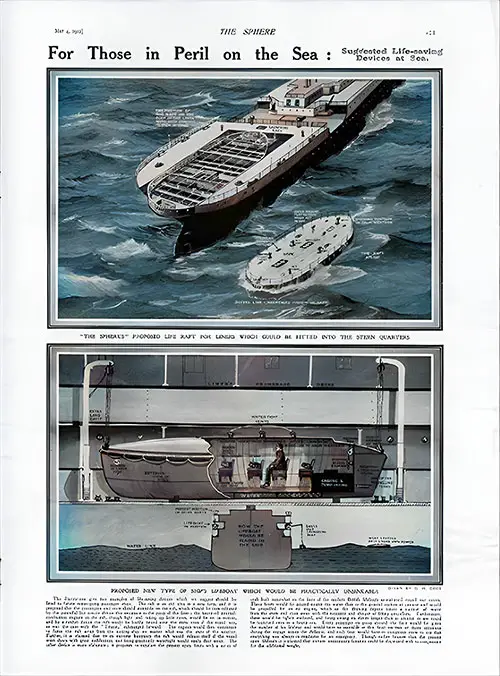
For Those in Peril at Sea: Recommended Life-Saving Devices. (Top) the Sphere’s Proposed Life Raft for Liners, Designed to Fit in the Stern Quarters. (Bottom) Proposed New Type of Lifeboat That Would Be Practically Unsinkable. The Sphere, 4 May 1912. GGA Image ID # 11027e176c
The illustrations present two practical and feasible life-saving devices that should be fitted to future ocean-going passenger ships. The raft, a practical solution, is reimagined in a new form.
It is proposed that the passengers and crew should assemble on the raft, which should be then released by the powerful but simple device that secures it to the poop of the liner. The heavy-oil internal combustion engines on the raft, though light and taking up little room, would be set in motion. By a ratchet device, the raft would be bodily forced over the stern even if the vessel was, as was the case with the Titanic, submerged forward. This system ensures a swift and efficient evacuation, potentially saving lives in emergency situations.
The engines would then commence to force the raft away from the sinking ship no matter the weather's state. Further, it is claimed that by its extreme buoyancy, the raft would release itself if the vessel went down with great suddenness and, practically watertight, would easily float away. Another device is more elaborate; it proposes to supplant the present open boats with a series of Practically Unsinkable craft built somewhat on the lines of modern British lifeboats stationed around our coasts.
These boats would be placed nearer the water than is the general custom. They would be propelled by an oil engine, which, as the drawing depicts, forces a current of water from the stern and eliminates the necessity and danger of fitting propellers.
Furthermore, these would be lightly enclosed and swung on davits longer than they are currently in use, and they could be launched even in a heavy sea. Every passenger aboard the liner would be given the number of their lifeboat and would have to assemble at this boat on two or more occasions during the voyage across the Atlantic.
Each ship would have its competent crew to see that everything was always ready for an emergency. Though rather heavier than the present open lifeboats, certain unnecessary luxuries such as non-essential amenities or decorative elements could be dispensed with to compensate for the additional weight.
Key Highlights and Most Engaging Content
🔹 Front Cover & Composite Illustration of the Titanic’s Sinking – The front cover proclaims, "The Greatest Wreck in the World's Maritime History," setting the dramatic tone. The composite image reconstructing the Titanic's sinking—with icebergs sourced from Newfoundland photographs—was a significant attempt to visualize the event when few actual photographs were available.
🔹 Lavish Interiors & Gymnasium Illustrations – The images showcasing the Parisian Café, the swimming pool, the gymnasium with rowing machines, and private suites emphasize the luxury that contrasted with the disaster, making them some of the most evocative depictions of what was lost.
🔹 Diagrammatic Views of the Titanic’s Final Hours – Several technical illustrations reconstruct the event:
📍 The Titanic entering the iceberg stream
📍 A side-by-side diagram of lifeboats being lowered from the towering decks
📍 A haunting final image of the Titanic standing vertically before sinking These diagrams are among the most striking visual records of the event, useful for classroom discussions and academic essays.
🔹 The Human Side of the Tragedy: Passengers and Crew – The publication humanizes the disaster by featuring photos and biographies of well-known passengers and crew. Some of the most noteworthy mentions:
🎻 Titanic's Band Members – Highlighted as heroes who played "Nearer, My God, to Thee" as the ship sank.
📡 Wireless Operators Jack Phillips and Harold Bride – The crucial role of wireless communication in the disaster is illustrated through reproduced distress messages.
🔥 The Titanic’s Engineers – A solemn tribute to the 36 engineers who perished while keeping the ship’s lights running until the very end.
🔹 Survivor Accounts: Mr. Lawrence Beesley's Dramatic Narrative – As one of the first published survivor testimonies, Beesley’s eyewitness account is particularly powerful, providing detailed descriptions of the ship’s final moments, the confusion on deck, and the freezing conditions in the lifeboats.
🔹 Technological Innovations and Maritime Safety Lessons – Several sections analyze:
🔦 The Need for Searchlights on Ocean Liners – Illustrated with diagrams on how bright headlights could have prevented collisions with icebergs.
🚤 Proposed Lifeboat Reforms – New "practically unsinkable" lifeboat designs are introduced, advocating for a structured lifeboat assignment system.
Noteworthy Images and Their Importance 📷
🔸 The Titanic’s Last Vision at Cherbourg
A haunting nighttime depiction of the ship at port, glowing from hundreds of portholes, foreshadowing its tragic fate.
🔸 SOS Messages from the Titanic
Actual telegram transcripts between the Titanic and nearby ships, showcasing the urgency and confusion in those final hours.
🔸 The Iceberg That Sank the Titanic
An artist’s attempt to visualize the iceberg, offering insight into how survivors remembered it.
🔸 The Pressure on the Titanic at the Ocean Floor
A fascinating diagram illustrating the immense water pressure at over two miles deep, explaining why much of the wreckage was crushed.
🔸 The Scene Outside White Star Line Offices in Southampton
A heartbreaking depiction of grief-stricken families waiting for news.
🔸 How the Carpathia Rescued Survivors
Rare photographs of Titanic lifeboats approaching the Carpathia, taken by a passenger onboard.
Relevance for Teachers, Students, and Historians 📚
This collection is an essential historical resource for:
Teachers and Students – Offers primary source materials for essays, research papers, and class discussions on maritime history, social class disparities, and technological shortcomings.
Genealogists – Provides valuable images and names of notable passengers and crew, helping families trace their Titanic connections.
Historians – A rare look at early 20th-century journalism and how the Titanic was covered in real-time.
Maritime Enthusiasts – Features detailed ship diagrams and technical drawings that illustrate the Titanic’s engineering marvel and fatal flaws.
Final Thoughts & Encouragement to Students 📝
This visually rich and historically significant collection is an invaluable tool for students writing essays on the Titanic. Rather than relying on modern interpretations, students should use primary sources like those in GG Archives to develop well-researched and authentic historical narratives.
✍️ For Essay Inspiration: Consider writing on:
🔹 How the media depicted the Titanic disaster in 1912 vs. modern retellings.
🔹 The role of wireless telegraphy in maritime safety improvements.
🔹 A biography of a notable Titanic passenger using images and captions from this archive.
🚢 GG Archives remains an unparalleled resource for serious researchers. Dive into history with these primary sources and let the past tell its own story. 🌊
